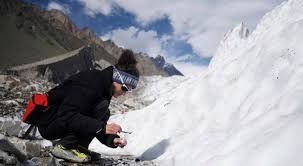Melting glaciers, rising risks: Italy supports Pakistan’s water security

Celina Ali
Islamabad: As climate change accelerates the melting of glaciers in northern Pakistan, Italy has stepped in with cutting-edge scientific research and international cooperation to help preserve the region’s vital “water towers”.
These glaciers, particularly in the Karakoram range, feed the Indus River and are essential for agriculture, hydropower, and daily life for millions.
With 13,032 glaciers covering more than 13,500 square kilometers, Pakistan holds Asia’s largest number of dryland glaciers. Yet these natural reservoirs are under threat from rising temperatures and shifting weather patterns, which are already causing erratic river flows. In early 2025, a nearly dry Kotri Barrage downstream in Sindh sent alarm bells ringing, illustrating the severe consequences of declining glacier melt for farmers and ecosystems.
Italy’s commitment to the region’s glaciers spans more than a century. From early 20th-century expeditions to modern satellite-guided glacier inventories, Italian scientists have played a foundational role in documenting and understanding glacier dynamics. The 1954 Italian ascent of K2 built on earlier research efforts led by figures like Duke of Abruzzi Roberto Lerco and geologist Ardito Desio. In the 1980s, Desio and climber Agostino Da Polenza co-founded EvK2CNR, launching decades of high-altitude environmental research.
Through partnerships with the United Nations Development Programme, Pakistani universities, and local institutions, Italy has helped create Pakistan’s most comprehensive glacier inventory, applying drones, satellite imaging, and field surveys to track changes in glacier volume and melt patterns. These efforts support critical water forecasting for agriculture and energy, while promoting environmental resilience.
Italy’s contribution extends beyond data collection. It has played a key role in establishing protected areas like Central Karakoram National Park, building local research capacity, and advancing biodiversity conservation. In March 2025, Da Polenza received a national award from the President of Pakistan, honoring Italy’s sustained role in environmental stewardship. The same month, the rare sighting of four snow leopards in the Karakoram region gave hope for the region’s ecological health.
Yet challenges persist. Mass tourism, unregulated development, and pollution threaten the fragile high-mountain ecosystems. Italian experts and their Pakistani counterparts are calling for stricter zoning laws, expanded weather monitoring, glacial lake surveillance, and stronger public education on the value of glaciers. They also emphasize the need for international policies that integrate glacier data into water and disaster planning.
Italy’s work has become a global model for glacier preservation. With 2025 declared the International Year of Glacier Preservation by the United Nations, the Italian–Pakistani partnership offers a blueprint for how scientific collaboration and shared commitment can help address one of the world’s most pressing climate challenges.
As glacier melt continues to reshape water security and food stability across Asia, Italy’s ongoing support shows how long-term cooperation and innovation can protect the natural systems on which millions depend.





